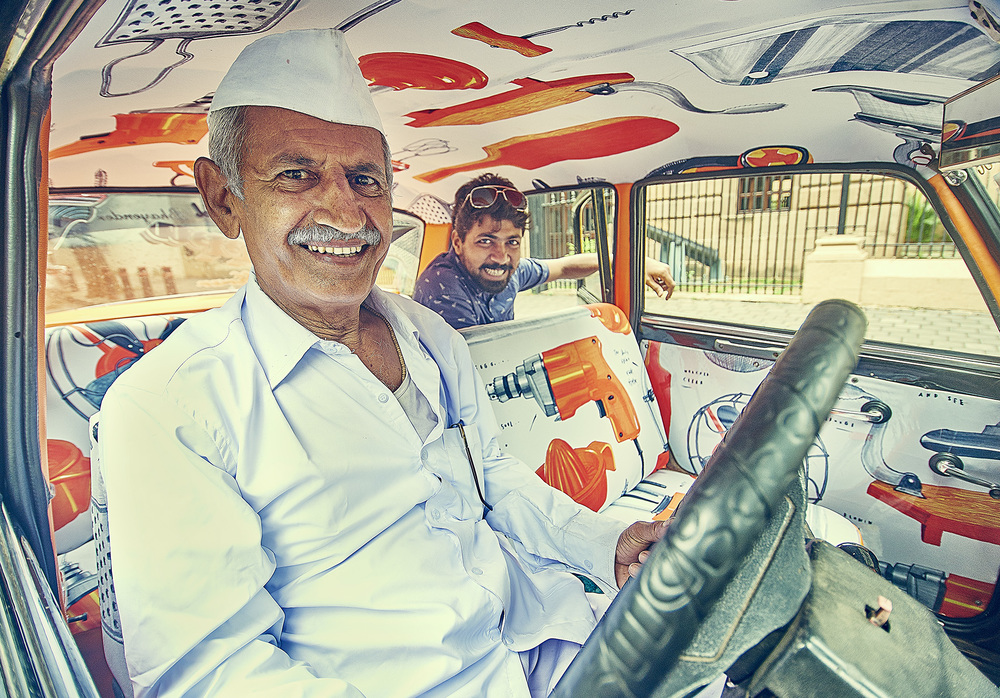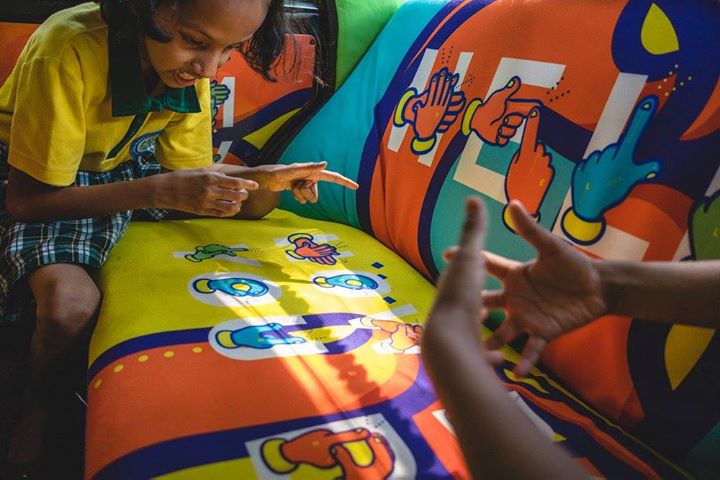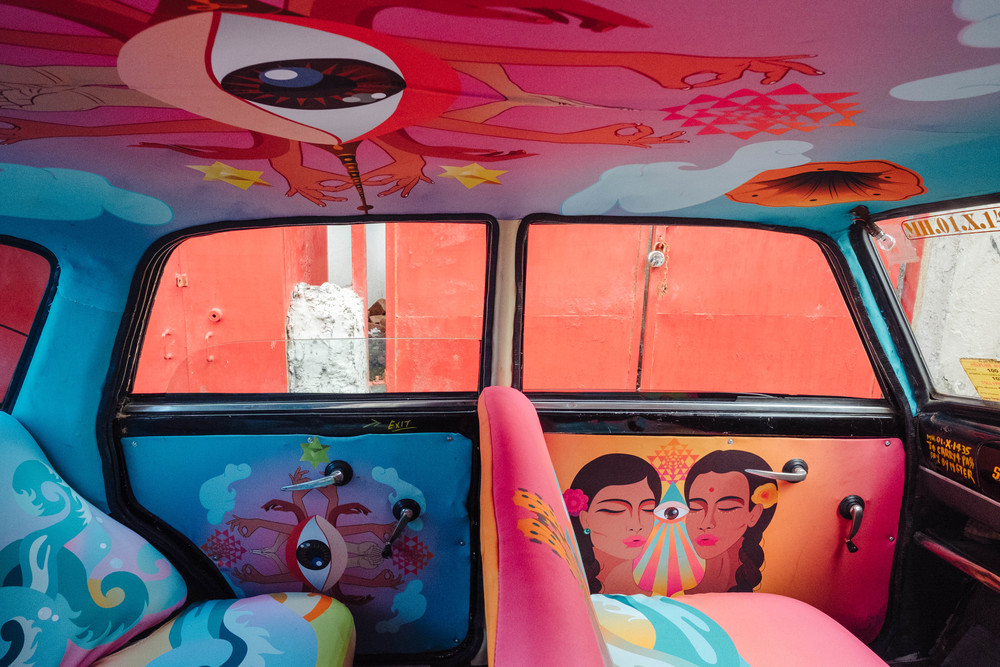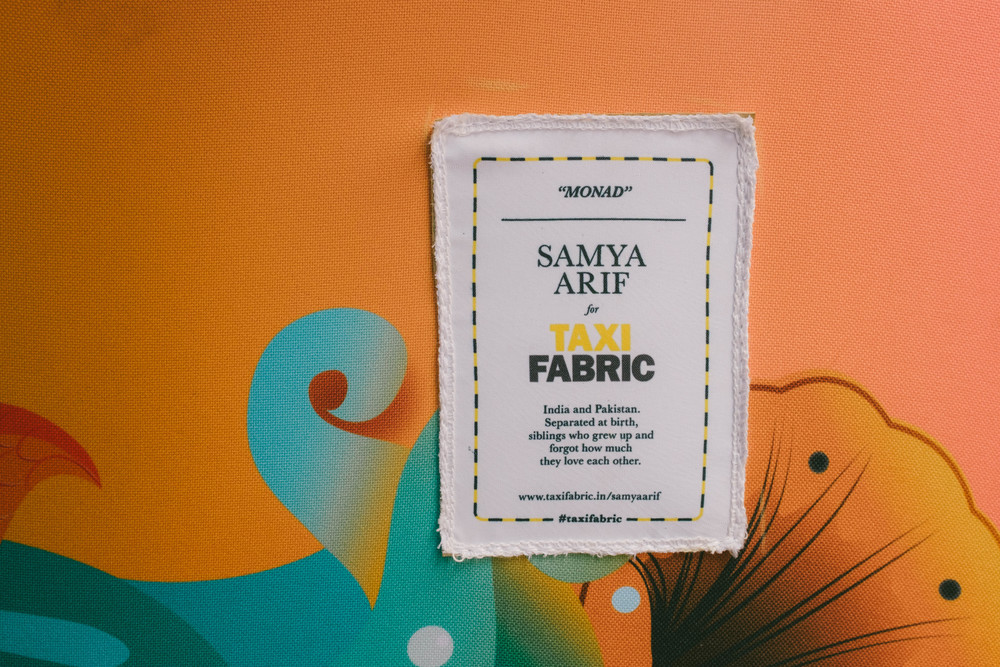By Saneela Jawad
In ‘Amchi Mumbai’ — the city of dreams, traffic and the most populous city in India — the iconic black and yellow taxis are the most convenient form of transportation in the city.
Home to more than 20 million people, the impressive 50,000 strong fleet of “Kaali Peelis” (black and yellows) were first launched back in 1911 and have become a ubiquitous part of the local culture — each with their own colorful design efforts to stand out including seat covers in worn-out velvet or textured faux leather, colorful trinkets hanging from the rear view mirror or tiny statuettes sitting on the dashboard.
Designer Sanket Avlani, however, decided to transform the city’s most convenient form of transportation into the most stylish – and powerful – canvas for local designers and help cab drivers redesign ‘their office.’

The Taxi Fabric project is slowly transforming cabs in the bustling city into works of art by reupholstering old and boring cab interiors into colorful, quirky, theme-driven fabrics that offer a functional and unforgettable taxi journey for thousands of riders. Designers interested in participating can submit their portfolio or Mumbai-inspired design concept to Taxi Fabric for review. Once the designer is reviewed, funding is secured and design is set with an interested cabbie, drivers participating in the project can get their seats reupholstered free of charge.
Taking the potential of the project to another level, Taxi Fabric recently collaborated with talented local designer Harshit Vishwakarma to raise awareness about India’s deaf community by designing a beautiful taxi seat cover to introduce sign language to the people of Mumbai.
Launched on World Deaf Day, the design is a brilliant initiative to reach out to India’s deaf and mute population – the largest in the world.

“After having experienced the prevailing gap between the deaf and the hearing communities in my college years, I wanted to intervene,” said Vishwakarma. “There are more sign language users in Bombay than in all of Europe. Taxi fabric was an opportunity to create a fun, engaging way for deaf as well as hearing individuals to learn how to finger spell in Indian Sign Language, especially all the alphabets.”
It also taps into the human tendency to unintentionally and sub-consciously grasp information and knowledge through one’s surrounding environment.
“The idea of doing it in a taxi was extremely interesting. Instead of people making an effort to learn the language, the language comes to them,” said Vishwakarma. “It was a conscious decision of not taking the route of sympathetic sensitization of people about the deaf community but to invite them to a conversation…[So] the next time you meet a deaf person, you don’t feel tongue tied’.”
“Nobody is born without ability. Each one has their own. These kids just need a little bit of support,” said Lata Nayak, principal of the Rotary Sanskardham Academy for the Hearing Impaired in Mumbai. “They don’t need your financial help. You should make an effort to learn their language and communicate with them.”
Bridging gaps through design
Having designed 13 taxis and one auto rickshaw so far, this project has become a remarkable platform for local emerging designers, capturing the imagination and attention of people all around the world.
“Each designer’s work has the potential to be exposed to at least 5,000 to 6,000 people in, say, six months,” said Avlani. “How many art exhibitions could offer that kind of opportunity?”

In addition to brightening up the taxi’s interiors and showcasing the work of local designers, the unique project is also bringing awareness to design as a profession in a country that often takes the potential of design and art for granted.
“The older generations take design for granted in India,” said the team behind Fabric Design. “Most of them don’t understand it or recognize it as a proper profession or something worth studying. Design to them just performs a function.”
The cabbies, however, could not be more thrilled with the opportunity to get a free makeover and attract more customers.
“My taxi looks really cheerful now and people are enjoying the experience,” said Pritam Singh, whose cab features graphic designer Pavithra Dikshit’s floral ‘Urban Garden’ design featuring lotus, jasmine, bamboo and nimbu-mirchi – the stringed evil-eye talisman made of lemon and green chillies that adorn almost every driver’s cab or rickshaw.
Avlani further added, ‘Some of them (drivers) have gotten double the number of customers after the makeover.’
The initiative has sparked some gorgeous blends of contemporary, traditional and edgy designs so far that celebrate different nostalgic and kitschy aspects of the local cultures including dabbawallas, little glasse tumblrs of chai, regional flora and fauna, and even freedom fighters.
The project even crossed borders by bringing together 29-year-old designer Samya Arif and elderly Sikh driver Satmant Singh in Mumbai for Independence Day.
The stunning design showcased the unique characteristics and cultural similarities between Indians and Pakistanis.
“The idea behind the designs for Taxi Fabric was to show how intricately and strongly Pakistanis and Indians are connected, not just through our history of independence but through similarities between our people, cultures, traditions, superstitions, ideals and so on, making us essentially the same kind of people,” Arif told The Express Tribune. “We have been conditioned falsely by our history books for too long, and I’m glad that artists as people are able to take a turn for the better and come together in celebrating art and spreading empathy.”
Our favorite part of the design was the neatly stitched words behind the driver’s seat reading, “India and Pakistan. Separated at birth, siblings who grew up and forgot how much they love each other.”






















These are awesome! I would love to ride in one of these…so stylish